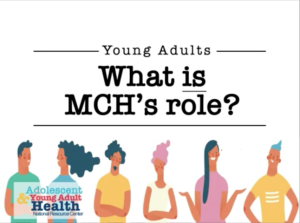Strategy 3: Provide Training on YA Health
Training to Take Action
Learning how to engage young adults benefits Title V professionals, partners and programs through improved expertise working with a large proportion of Title V participants. This section highlights methods for organizations at any stage of YA engagement to increase their young adult health knowledge, starting with the most accessible and ending with the most comprehensive methods.
✔ Use External Training Materials
External organizations have created a number of training materials that are available for public use. These materials offer a convenient resource for professionals to familiarize themselves with young adult health issues.
As a concise introduction to young adults & MCH, the University of Minnesota’s State Adolescent Health Resource Center, a partner in the Adolescent & Young Adult Health National Resource Center (AYAH-NRC), has published a series of YouTube videos on young adult health. They can be viewed on the sahrcUMN YouTube channel at the following links: 1) youtu.be/MSb225nav4w and 2) youtu.be/QPZDzAIC-ME
The first video, screen-captured on the left, provides a brief overview of how young adults fit into MCH’s goals, why to invest in their health and how Title V agencies can get started. The second video, “10 Things MCH Should Know about Young Adults,” offers a deeper dive into important data on young adults’ public health context. It touches on educational, socioeconomic and technology factors relevant to young adults’ health.
On the topic of mental health, a comprehensive resource bank is the Suicide Prevention Information and Resources for Educators (SPIRE), which compiles extensive resources on suicide prevention for educators at various levels. These resources include presentations, publications, and trainings.
Targeted resources are available for the High School, College/Graduate, and Medical School level as well as for Healthcare Professionals. The topics covered by SPIRE are suicide risk factors, screening tools, and treatment and referral.
✔ Avail of Technical Assistance
Resource centers, many of which are funded by the Maternal and Child Health Bureau, offer technical assistance to state Title V programs. Resource centers provide more personalized help to states that can be helpful when getting YA activities off the ground. Centers relevant to young adult health include the National Resource Center for Patient/Family-Centered Medical Home, the National Maternal and Child Health Workforce Development Center and the Adolescent and Young Adult Health National Resource Center, which prepared this resource.
| Peer Staff Help Boost College Student SNAP Enrollment |
| To improve enrollment of eligible students in California’s Supplemental Nutrition Assistance Program (SNAP), the University of California, Berkeley has hired college students to assist with SNAP enrollment on its campus. By employing members of the college community, the program benefits from their understanding of YAs’ needs. Eligible young adults may also be more easily identified and more likely to apply. Learn more |
✔ Hire Professionals with Young Adult Health Expertise

States can invest in YA health by hiring staff or consultants who have experience working with young adults and/or are young adults themselves. This expertise can help existing staff members learn firsthand about engaging this population. Allocating human resources this way also helps ensure that young adult health activities are fully incorporated into your Title V program.
To maintain YA expertise over time, formalized onboarding/offboarding processes and cloud storage of files are recommended (popular cloud storage services include Box, Dropbox and Google Drive). Improved knowledge of YAs will enable improved programming for Title V participants, discussed further in Strategy 4: Create YA Targeted Programs.
→ next: Strategy 4: Create Young Adult Targeted Programs
 University of California San Francisco
University of California San Francisco

